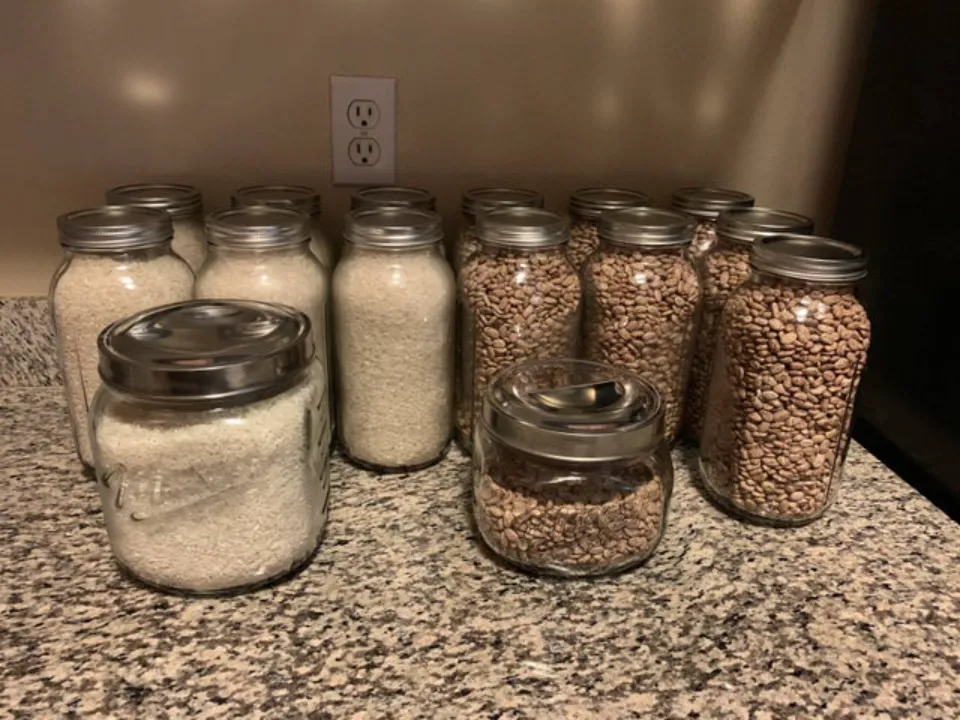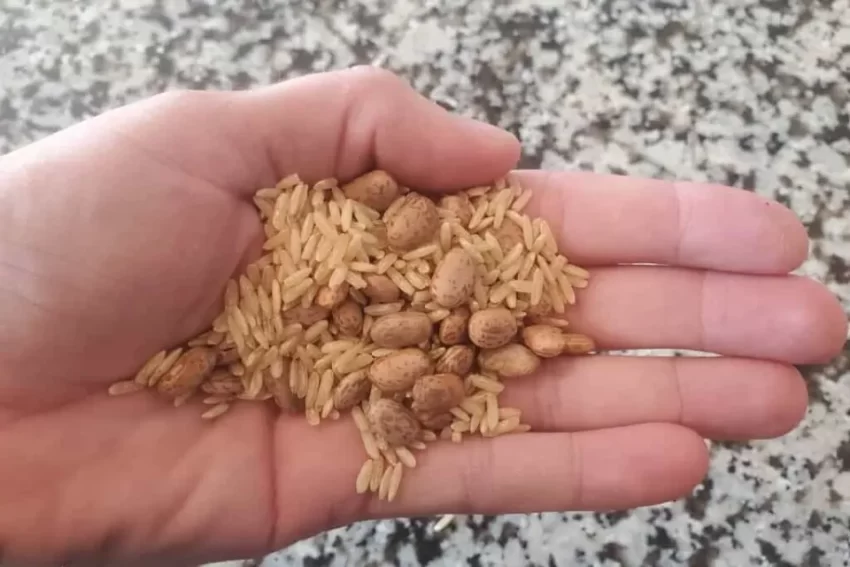Rice and beans are staples in most people’s pantries, but how to store rice and beans long term? Storing rice and beans long-term requires eliminating heat, light, moisture, and oxygen.
Fortunately, you can achieve the above conditions using storage containers and bags. Containers for storing food that are well-liked and practical include 5-gallon buckets, Mason jars, and mylar bags.
Let’s delve deeper into two strategies for long-term storage of rice and beans.
Table of Contents
How to Store Rice and Beans Long Term?
Here are two methods to store rice and beans in a long term.
Method 1: Store in Food-Grade 5 Gallon Bucket and Mylar Bags
To store the rice and beans, you can either pour them into separate buckets or transfer them into smaller mylar bags, which you can then put in the bucket. The rice and beans will receive additional security by being packaged in mylar bags. Here’s how you store it:
Step 1: Know Your Portions
Knowing how much rice and beans you’ll require for a year’s supply makes it simple to avoid buying more or less than you actually need.
25 to 60 pounds of rice and 30 to 60 pounds of legumes are typically consumed annually by one person. That means you’ll need a couple of 5-gallon buckets—each bucket holding around 30 lbs—to store 60lbs of rice and beans per person.
You can divide them into roughly ten mylar bags, each holding about 6 pounds, for smaller portions.
Step 2: Skip the Freezing
You might have heard that you should freeze grains and legumes to kill pests before transferring the food into the containers. However, by doing so, you’re adding moisture to the rice and beans, which creates ideal conditions for mold and bacteria to flourish.
See, the amount of water activity in food, or more simply, the amount of water present in food, is what allows spoilage organisms to grow and spread. Fortunately, raw beans and rice have little water activity. Because of this, they remain fresh for a long time. However, freezing your grains and legumes puts you at risk for increased moisture, which could lead to the growth of organisms that can cause food spoilage.
Plus, some grain insects and eggs can still survive temperatures lower than 0ºF, so freezing won’t necessarily make the rice bug-free.
Don’t worry if you’re worried about insect eggs in your container. In your containers, adding oxygen absorbers will have a similar impact on insects as a freezer. The oxygen absorbers will, as their name implies, absorb the air in the container, killing any pests therein. According to the size of the container, the table below shows how many oxygen absorbers you’ll need.
Step 3: Prepare the Bucket
Before placing anything in the bucket, first, make sure it’s in perfect condition. Here are a few tips to help maintain the food quality in the large container:
- Only use a food-grade 5-gallon bucket and make sure it’s BPA-free to avoid health risks related to BPA leaching.
- Double-check for cracks to make sure contamination won’t happen.
- Use Gamma Seal Lids for a tight seal, preventing air from reaching the food.
- Use soapy warm water to clean the bucket. After that, thoroughly air dry it by drying it with a clean towel. this one. this one…………….
Step 4: Fill the Mylar Bags
Typically, mylar bags used for food storage come in sizes ranging from one quart to six gallons. In comparison to a 1-gallon mylar bag, a 1-quart bag can hold about 3 lbs of grains or legumes. Choose the right size based on your preferences.
Step 5: Place in the Appropriate Storage Conditions
You should keep the buckets of rice in a dark, cool, and dry location at a temperature of about 40°F to increase the shelf life of the grain.
Beans can also be kept at a temperature of 40°F. They may, however, lose their oils and become dry if you intend to store them for longer than a year.
To maintain dry beans’ oils and nutritional value, it’s better to store them at 70ºF.
Method 2: Store in Mason Jars

If you consume beans and rice frequently and anticipate using the supply quickly, storing them in mason jars can be helpful. To store beans and rice in mason jars, here’s what you need to do:
- Wash the jars—preferably in the dishwasher—for sanitization, and then let them dry completely.
- Shake the jars before adding the dried food, leaving about 1 inch around the jar’s rim.
- For every quart, add 100cc oxygen absorbers and screw the lid on firmly.
- Another choice is to use the vacuum-sealer’s jar attachment, then screw on the outer band of the lid after sealing.
- Finally, add a date and store your jars away from light in a cool, dry place.
Read More: How To Store Brown Sugar Long-term?
Basic Principles for Storing Beans and Rice
When storing beans and rice, the storage methods that we discuss in this article follow the same basic principles:
- Dried beans and rice must be placed in a food-safe storage container with a lid or cover that tightly seals shut.
- Any rocks or broken beans you find must be removed.
- You must place the bean container in a cool and dry place away from sunlight – regardless of which storage method you choose.
How Do You Know If Dried Beans and Rice Are Too Old?
When they are bad, rice and beans often exhibit similar traits. In general, you should be alert for obvious signs like finding weevils or other insects, mold, or an unpleasant odor. If you notice insects, discoloring, or a harsh odor coming from the food items, dispose of them immediately.
You’ll know whether your dried beans are still safe to eat by making sure they adhere to the following standards:
- No Mold Growth: Check to see if your rice and beans are still fairly close to their original color. Consider rice or beans unfit for consumption if you see them with discolored skin, dark spots, or any other mold traces.
- No Signs of Pantry Bugs: Make sure there aren’t any bugs in the container or bag you’re using. You’ll also want to check if there are any signs of insect droppings. If so, you’ll need to throw out the beans.
- No Unusual Scents. Typically, dried beans don’t smell particularly good. If your bag of beans has a strong or unpleasant smell, it may be the result of mold, insect droppings, or fermentation.
Conclusion: How to Store Rice and Beans Long Term
So, if you’re looking to learn how to store rice and beans long-term, you can maintain the quality of rice and beans for up to 30 years by adding oxygen absorbers in mason jars, mylar bags, or food-grade buckets. Utilizing a vacuum sealer is an option if you want to go above and beyond.
Rice and beans are essential food staples when considering what to store long-term. Your ability to store rice and beans for a long time will be aided by your knowledge of what these ingredients contribute to the human diet and the fundamentals of food deterioration.
No matter the reason, it is not difficult to store rice and beans for a long time. Recognize that a constant temperature is best for the food. The better, the colder.
Also Read: How to Store Freeze Dried Food?
FAQs
How Long Can You Store Dry Rice and Beans?
Build gradually a supply of food that will keep you alive for a long time, such as wheat, white rice, and beans, for longer-term needs and where it is allowed. These items can last 30 years or more when properly packaged and stored in a cool, dry place.
What is the Best Way to Store Dried Beans Long Term?
If you want to store dried beans for longer than a month, put them in an airtight storage container, such as a mylar bag or a glass jar.
Can Rice Be Stored Indefinitely?
Milled rice can be kept on the pantry shelf for almost indefinitely if properly stored.

